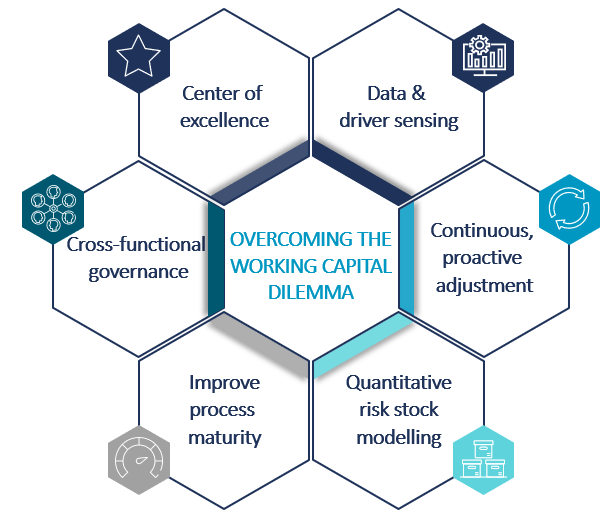Companies are facing a dilemma with regards to inventory and working capital management. On the one hand, an environment with ongoing global disruptions, volatile demand and unreliable supply requires more inventory as buffer. On the other hand, the inflation and a weak economy put an immense pressure on companies towards leaner inventories. In this article series, we discuss how this dilemma can be overcome and how inventories can be effectively managed in challenging times.
Dilemma of Upward and Downward Pressure on Inventories
Inflation is not only increasing the pressure on the cost of goods, but also impacting long-established ways of managing supply chains – like inventory management. As it is driving up direct costs for materials, labor, energy, and transportation, manufacturing, storing, and shipping goods become much more expensive. The rise of U.S. storage pricing by more than 10% year over one year illustrates this clearly.[1] Additionally, interest rates have risen back to levels not seen for more than a decade, putting higher pressure on companies to professionalize the management of working capital and inventory buffers.
Besides the ongoing economic crisis, the global logistics market has still not recovered to pre-pandemic times.[1] With heavy delays in manufacturing and shipping, lead times for the transport and supply of raw materials and components are very unreliable, making deterministic methods for planning and inventory parametrization more unfit than ever.
With this dilemma of upward and downward pressure on inventory levels in place, companies are struggling to take correct business decisions in managing inventories. In a nutshell, inventory is more important than ever before to reliably sustain supply in a disruptive environment, but at the same time expensive as never before. How to overcome the inventory management dilemma? From our experience, it needs a fundamentally different approach along six dimensions to live up to the challenge.
Six Pillars of Modern Inventory Management
A new inventory management approach needs to evolve different dimensions in an organization. The key to unlock the situation is a data-driven and more proactive stock parametrization logic, with continuous screening of the environment, and continuous adjustment of targets levels. Also risk stocks – which often have been defined in a more rule-of-thumb or judgement-based way – need to be optimized based on data & analytics. Furthermore, the underlying drivers of inventories, such as demand variability or manufacturing lead time, need to be pro-actively managed and improved. Lastly, inventory management needs to be tightly integrated into overall processes and governance: this includes for example the correct integration with financial and budget planning, but also establishing a center of excellence that bundles the advanced capabilities for E2E inventory management in one central unit. Figure 1 depicts these pillars. We will explain each one in more detail in the following chapters.

Data & Driver Sensing
The foundation of modern inventory management is thinking of inventory as dynamic and adaptive, and as an outcome of a continuous stream of data which senses both the maturity of the supply chain (e.g., lead times, planning quality, reliability of execution) and includes factors from the environment (e.g., disruptive events, demand variability, supplier reliability).
This stream of data needs to relate to the right level of inventory parametrization based on a clear set of business rules, as outlined in figure 2. On the demand side for example, the commercial stock availability targets and prioritization/ segmentation are major drivers of the required safety buffers. These commercial inputs are by no means static, but continuously fine-tuned and adapted. On the supply side for example, the material, capacity, and labor shortages in 2022 have shown the need to dynamically adjust buffers to the environment. As a conclusion, driver data for inventory adjustments are to be maintained in a data lake and continuously updated, including the use of trending and signal detection to allow early identification of new patterns in the data.

Instead of looking at inventory levels top-down, starting with the drivers enables a bottom-up view and helps understanding the cash price tag of the current supply chain set-up. Asking questions like the following is the starting point for sustainable inventory optimization: Which underlying commercial segmentation supports the inventory strategy, and is it still up to date? How high is the demand volatility and how can forecasting performance be improved? How are re-order quantities derived? Do they depend on batch sizes or the manufacturing frequency? How does this influence the stock levels? What is the E2E throughput time and how does it disaggregate in different process steps? How can lead time be reduced on average, and how can variability around the average be decreased?
Continuous, Proactive Adjustment
Collecting data once or twice per year and recalculating stock parameters is clearly outdated. Companies need to move towards a continuous and real-time adjustment of the key driver data for stock levels. From our point of view, this includes four key capabilities:
- First, alert-based reviews of driver data changes, based on trending and early warning signals that are tailored to the specific parameters like e.g., variability in demand: This is critical to consistently reallocate the precious working capital where it is most needed to protect the business. By avoiding unproductive or dead stocks with limited value and re-allocating them to hot spots from a business or risk perspective, supply chain management can make a major contribution towards the resilience of the business.
- Secondly, we advise for automatic reparameterization runs of all parameters based on the latest data on the demand and supply side at least once a week.
- Thirdly, the application of segmentation logic to determine parameter adjustments: Such a logic could for example be based on volume or importance of the underlying products. Stock parameters for less important products are only adjusted quarterly unless a massive change of the underlying drivers is detected. Important products would be prioritized.
- Last, but not least, the top changes (with largest impact) need to be reviewed and aligned with commercial and supply Planning (to determine the impact on net demands), and Finance (to assess the working capital impact).
Quantitative Risk Stock Modelling
In the current disruptive environment, structural preparedness through the right level of risk stocks plays a vital role. At the same time, risk stocks need to be deployed in a very thoughtful and economical way, not only based on rule of thumb or experience. Thus, companies need to further upgrade their capabilities and move to a quantitative determination of risk stocks.
Safety stocks are typically defined to buffer against uncertainty – of demand and supply – during replenishment lead time from one node to another. It is important to differentiate that the measures of uncertainty, like e.g., demand variability, rather focus on the so-called known unknowns, the typical variability of demand and supply patterns in recent history, e.g., the last three years.
In contrast to that, risk stocks need to be dimensioned to minimize the business impact of major infrequent disruptions (unknown unknowns). The logic of calculation is fundamentally different:
- It starts with the definition of risk events that need to be mitigated based on the corporate risk attitude, e.g., production disruption of three to four months to bring a production line back up to desired output level based on industry events in the last decade. This can be quantified with the time-to-recovery An average number must be estimated that reflects a possible risk event.
- Secondly, risk stocks should be based on sales and margin at risk, usually focusing on the value of the product. Sales at risk reflect the level, sales are endangered by the defined major risk events that have been estimated before (see 1).
- Thirdly, we need to adjust the stock by a factor accounting for the (known) supply volatility. Also, after the recovery of a risk event, usual variability of supply from upstream will apply and slow down the recovery (especially after the supply chain has been brought out of balance), and we need to buffer against that. In the case of an inbound stock position, this would be the performance of the supplier (OTIF).
In general, risk stocks need to be applied much more selectively than safety stocks. Holding risk stocks to minimize sales at risk during recovery from an (unknown) event is expensive and should only be applied for key strategic products/ customers or particularly weak nodes in the supply chain. Thus, risk stock should finally be deployed from an E2E network perspective, allocating the available risk inventory budget to the stock points with the highest sales value or margin at risk per 1 million Euro of risk inventory.

Figure 3 shows an example for the calculation of a traditionally defined safety stock including known demand and lead time variability versus a risk-led safety stock. The traditional formula leads to a safety coverage of ~13 days of stock, while the upstream focused risk-led safety stock leads to approximately five times this quantity, adding up to ~70 days of stock.
To manage inventory in the current challenging environment, this is not yet sufficient. The concept needs to be complemented by a methodology to improve overall process maturity and stabilize the underlying drivers of inventory, as well as an underlying governance and the establishment of a center of excellence. Our second article will focus on the three missing pillars.
Stay tuned!
[1] https://www.freightwaves.com/news/viewpoint-inventory-management-key-to-stifling-inflation
We would like to thank Florian Kreitz for his valuable contribution to this article.

